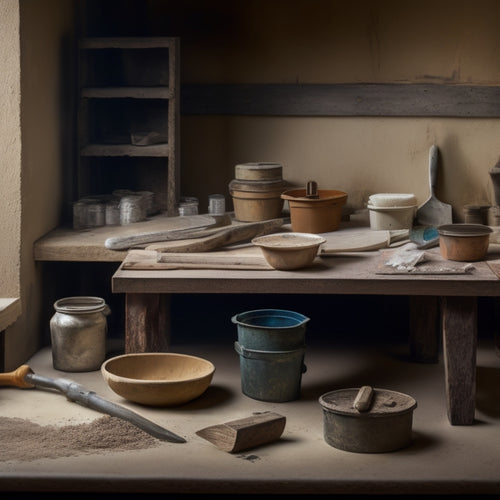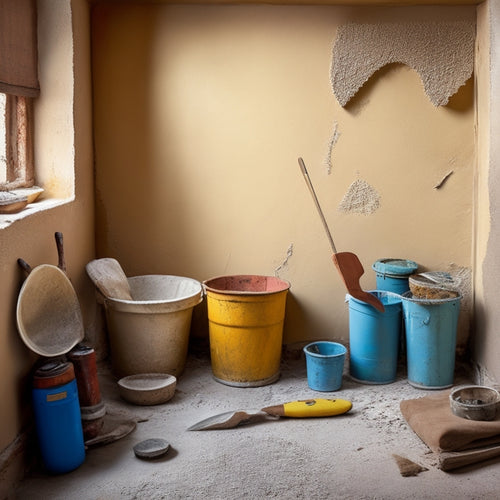
7 Best Tool Safety Guidelines for Home Renovation
Share
As you commence your home renovation project, guarantee your safety on the job site by following essential tool safety guidelines. Wear protective gear, including eyewear, gloves, and safety footwear, to prevent injuries from flying debris and sharp objects. Inspect tools before use, checking for wear, damage, and malfunctions. Select the right tool for each task, and avoid improvising or modifying tools, which can lead to accidents and injuries. Regularly maintain tools, preventing unexpected breakdowns, and clear walking paths to prevent slip and fall hazards. By following these guidelines, you'll be well on your way to a safe and successful renovation - and understanding the nuances of each guideline will bring even greater peace of mind.
Key Takeaways
• Wear protective gear, including eyewear, gloves, and safety footwear, to prevent injuries and ensure overall safety on the job site.
• Inspect tools before use, checking for wear, damage, and malfunctions, and assess ladders for sturdiness and secure footing.
• Use tools for their intended purpose, avoiding improvisation and ensuring compatibility with materials, and follow manufacturer guidelines for effective results.
• Regularly maintain tools by cleaning, lubricating, and inspecting them to prevent malfunctions and extend lifespan, and store them properly to prevent rust and deterioration.
• Prevent slip and fall hazards by clearing walking paths, securing floor surfaces, and removing tripping hazards, and maintain proper posture to avoid overreaching and stretching.
Wear Protective Gear Always
When working on a home renovation project, you must don the right protective gear to shield yourself from potential hazards, including flying debris, sharp objects, and toxic substances. You know, the usual suspects that can turn your DIY dreams into a nightmare.
So, before you start hammering away, make sure you're equipped with the essentials. First and foremost, grab your protective eyewear. You don't want a stray splinter or loose screw flying into your peepers, do you?
Next, slip on those safety gloves. They'll protect your hands from cuts, abrasions, and other nasty injuries. Trust us, you won't regret it. In fact, think of them as your BFFs (best friends forever) on the job site.
With your eyes and hands protected, you can focus on the task at hand – transforming your space into a stunning sanctuary. So, gear up and get to work! Your safety (and your sense of humor) will thank you.
Inspect Tools Before Use
Before putting any tool to use, scrutinize it carefully for signs of wear and tear, damage, or malfunction that could compromise your safety or the quality of your work. A thorough tool inspection is essential to avoiding accidents and ensuring a successful renovation project.
Here's a safety checklist to get you started:
| Tool | Inspection Technique | Action Required |
|---|---|---|
| Drill | Check for frayed cords, worn-out bits, and loose handles | Replace worn-out parts, tighten handles |
| Saw | Inspect for sharpness, rust, and loose blades | Sharpen or replace dull blades, oil rusty parts |
| Hammer | Look for cracks, loose handles, and worn-out grips | Replace cracked or worn-out handles, rewrap grips |
| Ladder | Check for sturdiness, rust, and slippery rungs | Repair or replace unstable ladders, sand rusty parts |
Tool Storage for Concrete Block Projects
Organize your tool storage area to guarantee easy access to the right tools for your concrete block project, and to prevent damage to your equipment and potential safety hazards.
You don't want to be stuck searching for that one specific trowel while your mortar is drying, or worse, tripping over scattered tools and risking injury.
Invest in storage solutions like toolboxes, bins, and hooks to keep your tools tidy and within reach. Label each container so you can quickly identify what's inside.
For heavy-duty tools like mixers and saws, designate a specific area with enough space to maneuver and store them safely.
Consider a pegboard for hanging frequently used tools, and assign a specific spot for each one to maintain tool organization.
By implementing these strategies, you'll save time, reduce frustration, and guarantee a safer working environment.
Prevent Slip and Fall Hazards
When you're working on a home renovation project, you'll need to take steps to prevent slip and fall hazards that can lead to serious injuries.
You'll want to make sure you're actively maintaining clear walking paths, securing floor surfaces, and removing tripping hazards to minimize the risk of accidents.
Clear Walking Paths
You must guarantee that all walking paths in your home renovation area are clear of debris, tools, and materials to prevent slip and fall hazards that can cause injuries or fatalities. It's essential to maintain a tidy workspace, not just for aesthetics, but for your safety and the safety of others. Clear walking paths also enable you to move efficiently around the renovation area, reducing fatigue and improving productivity.
| Area | Clearance Requirements |
|---|---|
| Workstations | Ensure a 3-foot radius around each workstation is clear of obstacles and tripping hazards. |
| Aisles | Maintain a minimum width of 4 feet for main aisles and 3 feet for secondary aisles. |
| Stairways | Keep stairways clear of debris, tools, and materials to prevent slip and fall hazards. |
Remember to take into account ergonomic considerations when designing your workspace. Make sure that frequently used tools and materials are within easy reach to reduce strain and fatigue. Additionally, meet lighting requirements by providing adequate illumination in the renovation area to prevent eye strain and reduce the risk of accidents. By following these guidelines, you'll be well on your way to creating a safe and efficient home renovation area.
Secure Floor Surfaces
To prevent slip and fall hazards, ascertain that all floor surfaces in your home renovation area are securely covered with non-slip materials or coatings, particularly in areas where water, oil, or other substances may be present.
You don't want to become a human slip 'n slide, right? Ensure that your flooring materials provide adequate surface traction to prevent accidents.
For instance, apply non-slip coatings or mats to smooth surfaces like tile, wood, or metal. You can also install textured flooring materials, such as rubber or PVC, to increase grip.
Additionally, make sure to clean up spills immediately to prevent slippery surfaces. Don't let your renovation area turn into a hazardous zone!
By taking these precautions, you'll be well on your way to a safe and successful renovation project. Remember, safety always comes first, so don't skimp on securing your floor surfaces.
With a little planning and attention to detail, you can prevent slip and fall hazards and keep your renovation project on track.
Remove Tripping Hazards
Every inch of your home renovation area must be thoroughly inspected to identify and remove tripping hazards, as a single overlooked obstacle can lead to a devastating slip and fall accident. You can't afford to miss a thing, not even a stray wire or a misplaced tool. To help you stay on top of tripping hazard identification, here are some common culprits to watch out for:
| Tripping Hazard | Hazard Prevention Strategies |
|---|---|
| Loose cords and wires | Secure them with cable ties or tape |
| Tools and materials | Store them in designated areas, off the floor |
| Uneven flooring | Install temporary ramps or cover uneven areas with non-slip mats |
Avoid Overreaching and Stretching
Avoid Overreaching and Stretching
Overexertion injuries often occur when homeowners stretch or lean beyond a comfortable range to access tools or materials, compromising their stability and balance. You might be thinking, 'Just one more stretch and I'll get that screwdriver!' But trust us, it's not worth the risk.
To avoid overreaching and stretching, you'll want to focus on using ergonomic techniques to optimize your workspace. Start by maintaining proper posture – keep your feet shoulder-width apart, knees slightly bent, and back straight. This will give you a solid foundation to work from.
Next, position your tools and materials at a comfortable height to minimize bending or stretching. If you need to reach something, use a ladder or step stool instead of overextending yourself.
Remember, it's better to take an extra minute to set up your workspace safely than to risk injury. By following these simple tips, you'll be well on your way to a safe and successful home renovation project.
Use Tools for Intended Purpose
When you're working on a home renovation project, it's essential that you use tools for their intended purpose to prevent accidents and guarantee effective results.
You'll need to select the right tool for the job, avoiding the temptation to improvise with a nearby substitute that could lead to disaster.
Right Tool for Job
By selecting the right tool for the job, you can assure that your renovation tasks are completed efficiently and safely, while also preventing damage to the tool itself or the surrounding materials.
It's essential to choose a tool that's compatible with the task at hand, taking into account factors like material, size, and weight. A mismatch can lead to accidents, wasted time, and a whole lot of frustration.
To ascertain you're making the right tool selection, consider the following:
-
Check the manual: Read the manufacturer's instructions to understand the tool's intended use and any specific guidelines.
-
Assess the task: Evaluate the task's requirements, including the type of material, size, and complexity.
-
Consider the environment: Think about the workspace, including factors like lighting, ventilation, and accessibility.
- Don't compromise: If you're unsure about the right tool for the job, don't take a chance – it's better to wait than to risk your safety or the tool's integrity.
Avoid Improper Modifications
You're more likely to compromise your safety and the tool's performance if you modify a tool to perform a task it wasn't designed for. That's a recipe for disaster! Improper modifications can lead to accidents, injuries, and even fatalities.
Don't try to MacGyver your way through a renovation project; it's just not worth the risk. Stick to using tools for their intended purpose. The manufacturer designed them to perform specific tasks, and deviating from those tasks can lead to serious consequences.
Remember, safety standards are in place for a reason. They're meant to protect you, the user, from harm. When you modify a tool, you're fundamentally overriding those safety standards, which can result in electrical shock, flying debris, or other hazards.
Don't become a statistic! Keep your tools in their original condition, and use them as intended. Your safety, and the success of your renovation project, depend on it.
Follow Manufacturer's Instructions
Operating your power tools in accordance with the manufacturer's instructions is vital to guaranteeing a safe and successful renovation project. You wouldn't want to risk invalidating your tool warranty or compromising your safety, would you? It's important to read and understand the manual before using your tools, as it provides valuable information on proper usage, maintenance, and troubleshooting.
Here are some key takeaways to keep in mind:
-
Always use the correct accessories: Using the wrong accessories can lead to accidents and damage to your tools.
-
Respect the tool's power: Don't push your tools beyond their limits, as this can cause overheating, motor damage, or even electrical shock.
-
Perform regular maintenance: Regular cleaning, lubrication, and inspection can help prevent malfunctions and extend the lifespan of your tools.
- Comply with manufacturer guidelines: Following the manufacturer's instructions guarantees you're using the tool as intended, which is essential for manufacturer compliance and maintaining your tool warranty.
Regularly Maintain Tools and Equipment
Proper maintenance of your tools and equipment is essential to guaranteeing they remain in good working condition, preventing unexpected breakdowns, and reducing the risk of accidents.
You don't want your trusty drill to suddenly conk out on you in the middle of a project, leaving you frustrated and stuck. By following some simple tool maintenance tips, you can extend the life of your equipment and avoid those pesky surprises.
For instance, regularly clean your tools to prevent dirt and debris buildup, and store them in a dry place to prevent rust. Lubricate moving parts, and check for worn-out components that need replacing.
Implementing equipment longevity strategies like these won't only save you time and money but also guarantee your safety on the job site.
Frequently Asked Questions
What Are the Recommended Brands for Durable Tool Storage Containers?
When it comes to keeping your tools organized and within reach, you'll want durable storage containers that can withstand the chaos of your workshop.
For high-quality tool organization and storage solutions, you can't go wrong with brands like DeWalt, Milwaukee, or Bosch.
Their containers are built to last, with rust-resistant materials and clever designs that'll keep your tools tidy and easily accessible.
Trust us, your sanity (and your tools) will thank you!
Can I Use Safety Glasses With Prescription Lenses?
You're wondering if you can rock safety glasses with prescription lenses, right? Absolutely!
Prescription safety glasses are a thing, and they're a game-changer. You'll find lens options tailored to your specific prescription needs, ensuring you see clearly while staying protected.
From single vision to progressive lenses, there's a solution for you. So, go ahead and get your prescription safety glasses – your eyes (and your DIY project) will thank you!
Are There Any Specific Regulations for Home Renovation in My Area?
You're wise to wonder if your local authorities are breathing down your neck, waiting for you to slip up on those renovation permits.
The truth is, regulations vary wildly depending on your location. Research local building codes to avoid costly surprises.
In the US, for instance, the International Residential Code (IRC) sets standards, but your city or county may have additional rules.
Don't get caught in a bureaucratic nightmare – get informed and get permits!
How Often Should I Replace My Tool's Worn-Out Handles?
When it comes to handle maintenance, you shouldn't wait until your tools start feeling like they're in a wrestling match with you.
Check your handles regularly for signs of wear, like cracks, splinters, or loose grips.
As a rule of thumb, replace them every 6-12 months or sooner if you notice any damage.
Can I Share Power Tools With My Neighbors or Friends?
Swapping sweet treats with your neighbors? Absolutely!
But sharing power tools? Not so fast! You'd be surprised how quickly a borrowed drill can become a lawsuit waiting to happen.
Before lending out your trusty tools, make sure your friends and neighbors are familiar with your safety protocols.
Better yet, create a tool-sharing agreement that outlines usage, maintenance, and liability.
Don't let a kind gesture turn into a costly mistake.
Conclusion
As you commence your home renovation journey, remember that tool safety isn't a suggestion, it's a necessity.
By wearing protective gear, inspecting tools, storing them properly, preventing slip and falls, avoiding overreaching, using tools for their intended purpose, and maintaining them regularly, you'll minimize risks and guarantee a successful project.
Stay vigilant, stay safe, and get the job done efficiently – your well-being and project's success depend on it.
Related Posts
-

5 Must-Have Plastering Tools for Safe Renovation
You'll need a range of essential tools to tackle your plastering project safely. Invest in a variety of trowels, incl...
-

Top 5 Plastering Tools for Small Renovation Jobs
For small renovation jobs, you'll want to start with the top 5 crucial plastering tools: a putty knife for applying a...
-

Stucco Patching Material Checklist for Home Renovation
You'll need a range of essential tools, including a putty knife, wire brush, hawk or flat trowel, level, and straight...


